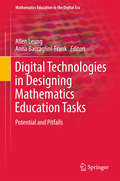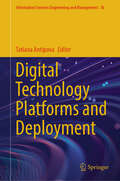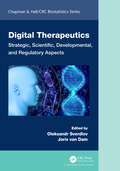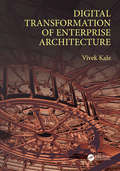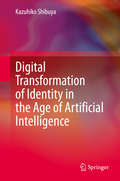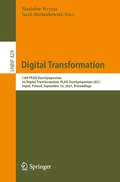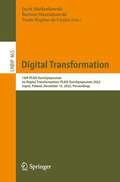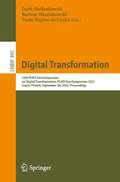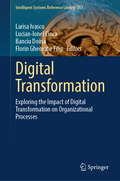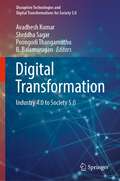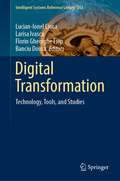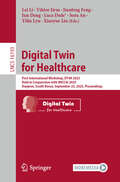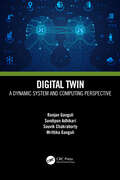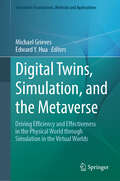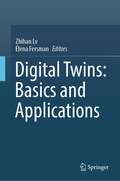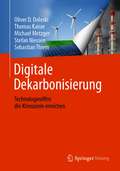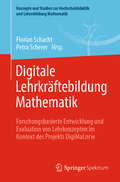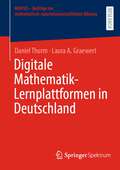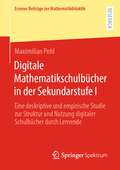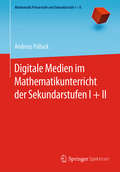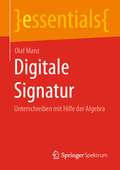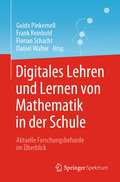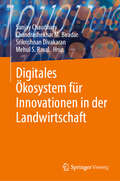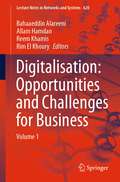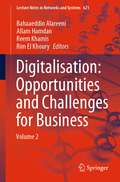- Table View
- List View
Digital Technologies in Designing Mathematics Education Tasks
by Allen Leung Anna Baccaglini-FrankThis book is about the role and potential of using digital technology in designing teaching and learning tasks in the mathematics classroom. Digital technology has opened up different new educational spaces for the mathematics classroom in the past few decades and, as technology is constantly evolving, novel ideas and approaches are brewing to enrich these spaces with diverse didactical flavors. A key issue is always how technology can, or cannot, play epistemic and pedagogic roles in the mathematics classroom. The main purpose of this book is to explore mathematics task design when digital technology is part of the teaching and learning environment. What features of the technology used can be capitalized upon to design tasks that transform learners' experiential knowledge, gained from using the technology, into conceptual mathematical knowledge? When do digital environments actually bring an essential (educationally, speaking) new dimension to classroom activities? What are some pragmatic and semiotic values of the technology used? These are some of the concerns addressed in the book by expert scholars in this area of research in mathematics education. This volume is the first devoted entirely to issues on designing mathematical tasks in digital teaching and learning environments, outlining different current research scenarios.
Digital Technology Platforms and Deployment (Information Systems Engineering and Management #36)
by Tatiana AntipovaThis book presents an investigation of empirical and theoretical data pertaining to wealth issues based on Digital Platforms and Deployment of Artificial Intelligence across a range of Domains. Digital technologies have rapidly transformed human existence, giving rise to a series of questions surrounding the nature of this transformation, the possible advantages and disadvantages of these technologies, and their potential implications and the directions they may lead us in. The identification of these consequences necessitates coordinated and interdisciplinary research efforts, given the common nature of digitalisation and its deep convergence of various scientific fields. The objective of this book is to provide a foundation for continuous learning and research, thereby equipping readers with the requisite knowledge, instruments and understanding to remain at the forefront of this rapidly evolving environment. The publication of "Digital Technology Platforms and Deployment" serves as a valuable resource for a diverse audience, including students, researchers and scientists specialising in areas such as Healthcare and Population, Computer Science, Artificial Intelligence, Education and Engineering. It is equally suitable for experts and academics/scientists from various scientific disciplines, since it serves as a catalyst for thinking and searching for new areas of research.
Digital Therapeutics: Strategic, Scientific, Developmental, and Regulatory Aspects (Chapman & Hall/CRC Biostatistics Series)
by Oleksandr Sverdlov Joris Van DamOne of the hallmarks of the 21st century medicine is the emergence of digital therapeutics (DTx)—evidence-based, clinically validated digital technologies to prevent, diagnose, treat, and manage various diseases and medical conditions. DTx solutions have been gaining interest from patients, investors, healthcare providers, health authorities, and other stakeholders because of the potential of DTx to deliver equitable, massively scalable, personalized and transformative treatments for different unmet medical needs. Digital Therapeutics: Scientific, Statistical, Clinical, and Regulatory Aspects is an unparalleled summary of the current scientific, statistical, developmental, and regulatory aspects of DTx which is poised to become the fastest growing area of the biopharmaceutical and digital medicine product development. This edited volume intends to provide a systematic exposition to digital therapeutics through 19 peer-reviewed chapters written by subject matter experts in this emerging field. This edited volume is an invaluable resource for business leaders and researchers working in public health, healthcare, digital health, information technology, and biopharmaceutical industries. It will be also useful for regulatory scientists involved in the review of DTx products, and for faculty and students involved in an interdisciplinary research on digital health and digital medicine. Key Features: Provides the taxonomy of the concepts and a navigation tool for the field of DTx. Covers important strategic aspects of the DTx industry, thereby helping investors, developers, and regulators gain a better appreciation of the potential value of DTx. Expounds on many existing and emerging state-of-the art scientific and technological tools, as well as data privacy, ethical and regulatory considerations for DTx product development. Presents several case studies of successful development of some of the most remarkable DTx products. Provides some perspectives and forward-looking statements on the future of digital medicine.
Digital Transformation of Enterprise Architecture
by Vivek Kale"In this book, Vivek Kale makes an important contribution to the theory and practice of enterprise architecture … this book captures the breadth and depth of information that a modern enterprise architecture must address to effectively support an agile enterprise. This book should have a place in every practicing architect's library." —John D. McDowall, Author of Complex Enterprise Architecture Digital Transformation of Enterprise Architecture is the first book to propose Enterprise Architecture (EA) as the most important element (after Business Models) for digital transformation of enterprises. This book makes digital transformation more tangible by showing the rationale and typical technologies associated with it, and these technologies in turn reveal the essence of digital transformation. This book would be useful for analysts, designers and developers of future-ready agile application systems. This book proposes that it is the perennial quest for interoperability & portability, scalability, availability, etc., that has directed and driven the evolution of the IT/IS industry in the past 50 years. It is this very quest that has led to the emergence of technologies like service-oriented, cloud, and big data computing. In addition to the conventional attributes of EA like interoperability, scalability and availability, this book identifies additional attributes of mobility, ubiquity, security, analyticity, and usability. This pragmatic book: Identifies three parts effort for any digital transformation: Business Models, Enterprise Architectures and Enterprise Processes. Describes eight attributes of EA: interoperability, scalability, availability, mobility, ubiquity, security, analyticity, and usability. Explains the corresponding technologies of service-oriented, cloud, big data, context-aware, Internet of Things (IoT), blockchain, soft, and interactive computing. Briefs on auxiliary technologies like integration, virtualization, replication, spatio-temporal databases, embedded systems, cryptography, data mining, and interactive interfaces that are essential for digital transformation of enterprise architecture. Introduces interactive interfaces like voice, gaze, gesture and 3D interfaces. Provides an overview of blockchain computing, soft computing, and customer interaction systems. Digital Transformation of Enterprise Architecture proposes that to withstand the disruptive digital storms of the future, enterprises must bring about digital transformation, i.e. a transformation that affects an exponential change (amplification or attenuation) in any aspect of the constituent attributes of EA. It proposes that each of these technologies (service-oriented, cloud, big data, context-aware, IoT, blockchain, soft, and interactive computing) bring about digital transformation of the corresponding EA attribute viz. interoperability, scalability, availability, mobility, ubiquity, security, analyticity, and usability.
Digital Transformation of Identity in the Age of Artificial Intelligence
by Kazuhiko ShibuyaThis book examines the digital transformation of identity in the age of artificial intelligence. It articulates the nature of identity of human beings, based on cutting-edge knowledge in the field of AI and big-data sciences, and discusses identity by drawing on comprehensive investigations in digital social sciences and exploring wider disciplines related to philosophy, ethics, sociology, STS, computer sciences, engineering, and medical sciences. Reviewing contemporary conditions proliferated by advanced technological trends and unveiling social mechanisms of human identity, this book appeals to undergraduate and graduate students as well as academic researchers.
Digital Transformation: 13th PLAIS EuroSymposium on Digital Transformation, PLAIS EuroSymposium 2021, Sopot, Poland, September 23, 2021, Proceedings (Lecture Notes in Business Information Processing #429)
by Stanisław Wrycza Jacek MaślankowskiThis book constitutes the refereed proceedings of the 13th PLAIS EuroSymposium 2021 which was held in Sopot, Poland, on September 23, 2021. The objective of the PLAIS EuroSymposium 2021 is to promote and develop high quality research on all issues related to digital transformation. It provides a forum for IS researchers and practitioners in Europe and beyond to interact, collaborate, and develop this field. The 10 papers presented in this volume were carefully reviewed and selected from 34 submissions. They were organized in topical sections named: digital enterprises; smart cities; digital education; and innovative methods in data and process analysis.
Digital Transformation: 14th PLAIS EuroSymposium on Digital Transformation, PLAIS EuroSymposium 2022, Sopot, Poland, December 15, 2022, Proceedings (Lecture Notes in Business Information Processing #465)
by Paulo Rupino da Cunha Jacek Maślankowski Bartosz MarcinkowskiThis book constitutes the refereed proceedings of the 14th PLAIS EuroSymposium 2022 which was held in Sopot, Poland, on December 15, 2022. The objective of the PLAIS EuroSymposium is to promote and develop high quality research on all issues related to digital transformation. It provides a forum for IS researchers and practitioners in Europe and beyond to interact, collaborate, and develop this field. The leading topic for the EuroSymposium this year was “Digital Transformation”. The 8 papers presented in this volume were carefully reviewed and selected from 23 submissions. They were organized in topical sections named: artificial intelligence; creativity and innovations; big data, internet of things and blockchain technologies.
Digital Transformation: 15th PLAIS EuroSymposium on Digital Transformation, PLAIS EuroSymposium 2023, Sopot, Poland, September 28, 2023, Proceedings (Lecture Notes in Business Information Processing #495)
by Paulo Rupino da Cunha Jacek Maślankowski Bartosz MarcinkowskiThis book constitutes the proceedings of the 15th PLAIS EuroSymposium on Digital Transformation, PLAIS EuroSymposium 2023, which took place in Sopot, Poland, in September 2023. The primary objective of the PLAIS EuroSymposium 2023 was to foster discussions on general issues pertaining to digital transformation and related topics. The papers selected this year are related to the use of machine learning, internet of things and social media. The 7 full papers included in this volume were carefully reviewed and selected from a total of 22 submissions.
Digital Transformation: Exploring the Impact of Digital Transformation on Organizational Processes (Intelligent Systems Reference Library #257)
by Florin Gheorghe Filip Larisa Ivascu Lucian-Ionel Cioca Banciu DoinaThe book offers aspects related to the health and process safety field, complex approaches to artificial intelligence, the role of accounting and auditing in the digital age, DT in agriculture, artificial intelligence in the maritime domain, education, management, sustainability and mobile technologies in learning. Digitization, digitalization and digital transformation (DT) are important for public organizations and private organizations. Despite their importance, these steps are approached differently in organizations. Public organizations emphasize the importance of digital transformation, while public organizations make efforts to align themselves with citizens' demands from a digitalization perspective. Incorporating technologies into organizational processes has become a priority for all industries to lead to important changes. All these activities are covered by the digital transformation that can lead to increased efficiency, agility, innovation and the unlocking of organizational values. Through this complex approach, the book contributes to the completion of knowledge in the field of digital transformation, develops and anticipates new research directions. It is addressed to professionals, practitioners, researchers, students and other interested parties.
Digital Transformation: Industry 4.0 to Society 5.0 (Disruptive Technologies and Digital Transformations for Society 5.0)
by B. Balamurugan Avadhesh Kumar Shrddha Sagar Poongodi ThangamuthuThis book focuses on computing for Industry 4.0 illustrating different domains with the purpose of integration with existing domains for automation of processes. It gives readers an idea about the various challenges and design structure for computing of Industry 4.0. The contents include contributions from experts in Cyber-Physical Systems (CPS), the Internet of Things (IoT), Industrial Internet of Things (IIoT), cloud computing, cognitive computing, and artificial intelligence across the world, contributing their knowledge to identify the different characteristics of the above domains.
Digital Transformation: Technology, Tools, and Studies (Intelligent Systems Reference Library #253)
by Florin Gheorghe Filip Larisa Ivascu Lucian-Ionel Cioca Banciu DoinaThis book presents a multidisciplinary approach to digital transformation process of organizational transformation, offering support throughout the implementation process to all those interested. The digital transformation (DT) is a priority for many companies in the context of technological evolution. The use of appropriate tools, methodologies, methods, approaches, and techniques for DT, depending on the organizational characteristics, can contribute to a complete approach to organizational processes and to their efficiency. Digital transformation involves the adoption and use of new digital technologies to develop new products and services, modify existing ones and develop new business models to increase efficiency, productivity, and competitiveness. Starting from marketing to culture and education to health, automotive, engineering, mobility and human resources and others, it is addressed to professionals, practitioners, researchers, students, and other interested parties.
Digital Twin for Healthcare: First International Workshop, DT4H 2025, Held in Conjunction with MICCAI 2025, Daejeon, South Korea, September 23, 2025, Proceedings (Lecture Notes in Computer Science #16193)
by Jianfeng Feng Jun Deng Lei Li Viktor Jirsa Luca Dede’ Sora An Yilin Lyu Xiaoyue LiuThis book, LNCS 16193, constitutes the proceedings of the First International Workshop on Digital Twin for Healthcare, DT4H 2025, held in conjunction with MICCAI 2025, in Daejeon, South Korea, during September 23, 2025. The 15 full papers included in the book were carefully reviewed and selected from 24 submissions. They deal with integrating Digital Twin frameworks with conventional medical imaging and computational tools, focusing on topics such as organ- and disease-specific DT modeling; multi-modal data integration; AI-driven simulation and prediction; DT-guided diagnostic and treatment planning; etc.
Digital Twin: A Dynamic System and Computing Perspective
by Ranjan Ganguli Sondipon Adhikari Souvik Chakraborty Mrittika GanguliThe digital twin of a physical system is an adaptive computer analog which exists in the cloud and adapts to changes in the physical system dynamically. This book introduces the computing, mathematical, and engineering background to understand and develop the concept of the digital twin. It provides background in modeling/simulation, computing technology, sensor/actuators, and so forth, needed to develop the next generation of digital twins. Concepts on cloud computing, big data, IoT, wireless communications, high-performance computing, and blockchain are also discussed. Features: Provides background material needed to understand digital twin technology Presents computational facet of digital twin Includes physics-based and surrogate model representations Addresses the problem of uncertainty in measurements and modeling Discusses practical case studies of implementation of digital twins, addressing additive manufacturing, server farms, predictive maintenance, and smart cities This book is aimed at graduate students and researchers in Electrical, Mechanical, Computer, and Production Engineering.
Digital Twins, Simulation, and the Metaverse: Driving Efficiency and Effectiveness in the Physical World through Simulation in the Virtual Worlds (Simulation Foundations, Methods and Applications)
by Michael Grieves Edward Y. HuaDive into the fascinating world of Digital Twins, Simulation, and the Metaverse, where the virtual/digital and physical worlds collide and reshape industries. This book offers an insightful exploration of the revolutionary applications of these technologies, promising to ignite your imagination and inspire innovation. The topics described in this book represent a groundbreaking exploration of the synergistic relationship between digital twins, simulation, and the metaverse, as well as their transformative impact across various sectors. In addition to presenting theoretical discussions and experimental findings, this book focuses on real-life applications and illuminates the path for future research. This makes it a must-read for both industry and academia keen on understanding and harnessing the power of the emerging technologies. Topics and features: Discover from top thought leaders the predictions of how digital twins, simulation, and metaverses will evolve in direction, requirements, and capabilities Exploit the understanding of how digital-twin metaverses will revolutionize the effectiveness and efficiency of 21st-century work Explore cutting-edge, real-life applications of digital twins, simulation, and the metaverse (spanning a diverse array of industries and sectors) Understand the different views and perspectives of digital twins and metaverses shared by academia, industry, and government authors from around the world Learn how to harness the power of simulation in the world of digital twins and metaverses This unique volume consists of works from internationally renowned experts representing a diverse array of industries and sectors. It will be eminently suitable for researchers and practitioners working on modeling and simulation, digital twins, and the metaverse. Furthermore, this volume will serve as a valuable reference for executives and decision makers who are looking to leverage these cutting-edge technologies to expand their businesses, develop industrial and national strategies, and support future missions.
Digital Twins: Basics and Applications
by Zhihan Lv Elena FersmanThis book comprehensively introduces readers to Digital Twins, from the basic concepts, core technologies and technical architecture, to application scenarios and other aspects. Readers will gain a profound understanding of the emerging discipline of Digital Twins. Covering the latest and cutting-edge application technologies of Digital Twins in various fields, the book offers practitioners concrete problem-solving strategies. At the same time, it helps those working in Digital Twins-related fields to deepen their understanding of the industry and enhance their professional knowledge and skills. Given its scope, the book can also be used as teaching material or a reference book for teachers and students of product design, industrial design, design management, design marketing and related disciplines at colleges and universities. Covering a variety of groundbreaking Digital Twins technologies, it can also provide new directions for researchers.
Digitale Dekarbonisierung: Technologieoffen die Klimaziele erreichen
by Thomas Kaiser Oliver D. Doleski Michael Metzger Stefan Niessen Sebastian ThiemDas Buch liefert erstmals konkrete Antworten auf die Frage, wie datenbasierte Verfahren bei der Dekarbonisierung von Betriebsprozessen helfen können. Der Text beschränkt sich dabei nicht auf die üblichen Ansätze zur Reduzierung klimaschädlicher Treibhausgasemissionen wie bspw. dem Verzicht des Einsatzes fossiler Energieträger. Vielmehr wird in dem Text der pragmatische und vor allem technologieoffene Blick auf die Dekarbonisierung energieintensiver Prozesse oder Verfahren gelenkt und dem Leser ein datenanalytisches Modell zur Optimierung des Energiesystems, welches dann deutlich weniger Treibhausgase emittiert, vorgestellt.
Digitale Lehrkräftebildung Mathematik: Forschungsbasierte Entwicklung und Evaluation von Lehrkonzepten im Kontext des Projekts DigiMal.nrw (Konzepte und Studien zur Hochschuldidaktik und Lehrerbildung Mathematik)
by Florian Schacht Petra SchererDieser Sammelband lotet die Möglichkeiten und Grenzen digital gestützter Maßnahmen für das Lehramtsstudium Mathematik – insbesondere im Primarbereich und in den Studiengängen des Lehramts Sonderpädagogik – aus. Ziel der entwicklungs- und forschungsbezogenen Beiträge ist es, die Gestaltung und Weiterentwicklung des Lehramtsstudiums mit digitalen Formaten voranzutreiben, deren vielfältige Potentiale aufzuzeigen und somit für Studierende die Zugänge zum Fach und zur Didaktik der Mathematik wirksam zu erweitern. Behandelt werden insbesondere folgende Fragen: Welche Potentiale und Grenzen bieten digital gestützte Lehr-Lern-Materialien im Lehramtsstudium Mathematik? Welche Konsequenzen ergeben sich aus dem Einsatz für die (Um-)Gestaltung entsprechender Lehrveranstaltungen? Welche empirischen Erkenntnisse lassen sich aus dem praktischen Einsatz ableiten? Die Beiträge beziehen sich sowohl auf fachbezogene Inhalte des Studiums (z. B. Geometrie, Arithmetik, Kombinatorik) als auch unterrichtspraktische Ausbildungsanteile zu fachdidaktischen Querschnittsthemen (z. B. Sprachbildung, Heterogenität), die mit digital gestützten Lehr-Lernmaterialien im Lehramtsstudium adressiert werden. Die Darstellungen orientieren sich an entwickelten Materialien, die in unterschiedlichen Lehrveranstaltungen der ersten Phase der Lehramtsausbildung (universitätsübergreifend) eingesetzt, evaluiert und ggf. überarbeitet wurden. Auf diese Weise entstehen sowohl fundierte Konzepte als auch theoriegeleitete und empirisch gestützte Beispiele für die Lehramtsausbildung. Chancen der Nutzung digitaler Formate – sowohl in der Distanz- als auch in der Präsenzlehre – können damit besser verstanden und praktisch weiterentwickelt werden.
Digitale Mathematik-Lernplattformen in Deutschland (MINTUS – Beiträge zur mathematisch-naturwissenschaftlichen Bildung)
by Daniel Thurm Laura A. GraewertDas Angebot digitaler Mathematik-Lernplattformen in Deutschland hat in den letzten Jahren stark zugenommen. Indem die auf den Lernplattformen dargebotenen Aufgaben um Erklärungen, Hilfestellungen und Tipps ergänzt, Aufgabenbearbeitungen unmittelbar ausgewertet und automatisierte Rückmeldungen gegeben werden, sollen die Lernprozesse von Schülerinnen und Schülern unterstützt werden. Der vorliegende Bericht wirft einen Blick auf die Aufgabenqualität deutschsprachiger, webbasierter Mathematik-Lernplattformen aus einer mathematikdidaktischen Perspektive.Die Befunde zeigen eine Dominanz von prozeduralen Aufgaben, wohingegen begriffliche Aufgaben deutlich seltener umgesetzt werden. Zudem werden mathematische Tätigkeiten wie das Argumentieren, das Modellieren und der Wechsel zwischen verschiedenen mathematischen Darstellungen selten angeregt. Durch die Fokussierung auf statische Visualisierungen werden die Potenziale von interaktiven, dynamischen Visualisierungen kaum genutzt. Auf Basis der Ergebnisse werden Ansatzpunkte zur Weiterentwicklung von digitalen Mathematik-Lernplattformen diskutiert.
Digitale Mathematikschulbücher in der Sekundarstufe I: Eine deskriptive und empirische Studie zur Struktur und Nutzung digitaler Schulbücher durch Lernende (Essener Beiträge zur Mathematikdidaktik)
by Maximilian PohlDie Forschungsarbeit beschäftigt sich mit digitalen Schulbüchern für die Mathematik der Sekundarstufe 1 und arbeitet eine Begriffsklärung zum Werkzeug „digitales (Mathematik-)Schulbuch“ heraus, fokussiert eine Strukturanalyse (deutschsprachiger) digitaler Mathematikschulbücher und erforscht die Nutzung dieses Lerngegestandes von Schülerinnen und Schülern.
Digitale Medien im Mathematikunterricht der Sekundarstufen I + II (Mathematik Primarstufe und Sekundarstufe I + II)
by Andreas PallackEin Blick in aktuelle Bildungsstandards und Lehrpläne zeigt: Die Nutzung digitaler Medien im Mathematikunterricht wird immer stärker eingefordert und geht heute weit über den Einsatz wissenschaftlicher Taschenrechner hinaus. Zukünftige Lehrerinnen und Lehrer müssen sich deswegen notwendig bereits im Rahmen ihrer Ausbildung mit digitalen Medien auseinandersetzen. Entsprechend wird hier ein Lehrwerk angeboten, das, orientiert an den Funktionalitäten digitaler Medien, Chancen und Risiken der Nutzung in mathematikpädagogischen Kontexten strukturiert darstellt. Zentrales Anliegen ist die Entwicklung von Medienkompetenz mit Blick auf das Lehren und Lernen im Fach Mathematik. Das Lehrwerk basiert auf erprobten und bewährten Veranstaltungen im Rahmen der Lehrerbildung.
Digitale Signatur: Unterschreiben mit Hilfe der Algebra (essentials)
by Olaf ManzBei klassischer Vorgehensweise werden die Identität des Erstellers und die Echtheit eines Dokuments durch manuelle Unterschrift auf Papier bezeugt. Dieses Vorgehen ist bei digitalen Texten und Nachrichten so nicht mehr möglich. Will man digitalisierte Daten unterschreiben und somit deren Echtheit und die eigene Identität bezeugen, so spricht man von einer digitalen Signatur. Dieses Buch beschreibt die drei wichtigsten Verfahren, nämlich die RSA-Signatur, die DSA-Signatur und die ECDSA-Signatur. Hierfür werden die jeweiligen algebraischen Grundlagen bereitgestellt.
Digitales Lehren und Lernen von Mathematik in der Schule: Aktuelle Forschungsbefunde im Überblick
by Florian Schacht Daniel Walter Frank Reinhold Guido PinkernellMit diesem Buch legen die Herausgeber einen umfassenden Überblick über den aktuellen Forschungsstand zur Digitalisierung des Lehrens und Lernens im schulischen Mathematikunterricht vor. Es soll Forschenden und Lehrkräften eine Orientierung für die Reflexion und Weiterentwicklung digitaler Werkzeuge und Medien und zugleich richtungsweisende Antworten auf die Frage geben, wie Digitalisierung sinnvoll gelingen kann, ohne zum Selbstzweck zu werden. Hierzu stellt eine Vielzahl von Autorenteams das Thema aus verschiedenen Blickwinkeln dar:Übergreifende Perspektiven: Theoretische und psychologische Grundlagen, Lehrkräfteprofessionalisierung, virtuelle Realität, digitale Lernumgebungen und WerkzeugeZentrale inhaltsorientierte Perspektiven: Arithmetik, Algebra, Funktionen, Geometrie und Stochastik sowie informatisches DenkenWichtige prozessorientierte Perspektiven: Modellieren, Argumentieren, Darstellen und Kommunizieren Ein abschließender Ausblick zu den „Future Directions“ in englischer Sprache macht deutlich, dass die Digitalisierung des Lehrens und Lernens nie abgeschlossen sein kann, sondern jeder gegenwärtige Stand auf die Zukunft bezogen sein muss.
Digitales Ökosystem für Innovationen in der Landwirtschaft
by Sanjay Chaudhary Mehul S. Raval Chandrashekhar M. Biradar Srikrishnan DivakaranDieses Buch präsentiert die neuesten Erkenntnisse auf dem Gebiet des digitalen Ökosystems für Innovationen in der Landwirtschaft. Das Buch ist in zwei Abschnitte mit dreizehn Kapiteln unterteilt, die sich mit spezialisierten Bereichen befassen. Es gibt dem Leser einen Überblick über die Rahmenbedingungen und Technologien, die an der Digitalisierung der Landwirtschaft beteiligt sind, sowie über die Methoden zur Datenverarbeitung, Entscheidungsfindung und innovativen Dienste/Anwendungen zur Förderung digitaler Transformationen in der Landwirtschaft. Die Kapitel wurden von Experten verfasst, die ihre Erfahrungen in verständlicher Sprache durch Fallstudien, geeignete Illustrationen und Tabellen teilen. Der Inhalt wurde entwickelt, um die Bedürfnisse der Geoinformatik, Datenwissenschaften, Landwirtschafts- und Umweltwissenschaften von Universitäten, landwirtschaftlichen Universitäten, technologischen Universitäten, Forschungsinstituten und akademischen Hochschulen weltweit zu erfüllen.Es unterstützt Planer, politische Entscheidungsträger und Erweiterungswissenschaftler bei der Planung und nachhaltigen Bewirtschaftung von Landwirtschaft und natürlichen Ressourcen.
Digitalisation: Volume 1 (Lecture Notes in Networks and Systems #620)
by Allam Hamdan Bahaaeddin Alareeni Reem Khamis Rim El KhouryThis book addresses the implications of technology, entrepreneurship, and business development gadgets for applications in societies. In this book proceedings, we attempt to address the importance and impact of digitalization and on business development in the context of economic diversity, that is through various propositions of modern technology and entrepreneurial actions, and through the lens of case studies, experiments, empirical assessments, just to name a few research methodological stances and approaches. This book highlights a range of topics in the fields of technology, entrepreneurship, business administration, accounting, and economics that can contribute to business development in developing countries, such as learning machines, artificial intelligence, big data, deep learning, game-based learning, management information system, accounting information system, knowledge management, entrepreneurship and social enterprise, corporate social responsibility and sustainability, business policy and strategic management, international management and organizations, organizational behavior and HRM, operations management and logistics research, controversial issues in management and organizations, turnaround, corporate entrepreneurship, and innovation, legal issues, business ethics, and firm governance, and firm financial affairs, non-traditional research, and creative methodologies. This book is ideal for academicians, activists, curriculum developers, researchers, professionals, administrators, and policymakers. The readers of this book could gain an up-to-date know-how on state-of-the-modern technology, entrepreneurship, and business development and achievements in this regard from the research standpoint of view.
Digitalisation: Volume 2 (Lecture Notes in Networks and Systems #621)
by Allam Hamdan Bahaaeddin Alareeni Reem Khamis Rim El KhouryThis book addresses the implications of technology, entrepreneurship, and business development gadgets for applications in societies. In this book proceedings, we attempt to address the importance and impact of digitalization and on business development in the context of economic diversity, that is through various propositions of modern technology and entrepreneurial actions, and through the lens of case studies, experiments, empirical assessments, just to name a few research methodological stances and approaches.This book highlights a range of topics in the fields of technology, entrepreneurship, business administration, accounting, and economics that can contribute to business development in developing countries, such as learning machines, artificial intelligence, big data, deep learning, game-based learning, management information system, accounting information system, knowledge management, entrepreneurship and social enterprise, corporate social responsibility and sustainability, business policy and strategic management, international management and organizations, organizational behavior and HRM, operations management and logistics research, controversial issues in management and organizations, turnaround, corporate entrepreneurship, and innovation, legal issues, business ethics, and firm governance, and firm financial affairs, non-traditional research, and creative methodologies.This book is ideal for academicians, activists, curriculum developers, researchers, professionals, administrators, and policymakers. The readers of this book could gain an up-to-date know-how on state-of-the-modern technology, entrepreneurship, and business development and achievements in this regard from the research standpoint of view.
